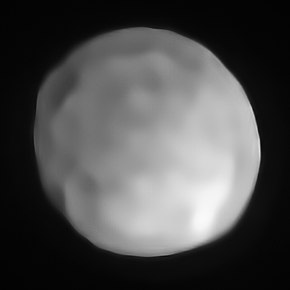 VLT-SPHERE image of Hygiea | |
| Discovery[1] | |
|---|---|
| Discovered by | A. de Gasparis |
| Discovery site | Astronomical Observatory of Capodimonte |
| Discovery date | 12 April 1849 |
| Designations | |
| (10) Hygiea | |
| Pronunciation | /haɪˈdʒiːə/[2] |
Named after | Hygieia[3] |
| A900 GA | |
| Main belt (Hygiea family) | |
| Adjectives | Hygiean /haɪˈdʒiːən/[4] |
| Symbol | |
| Orbital characteristics[1] | |
| Epoch 27 April 2019 (JD 2458600.5) | |
| Uncertainty parameter 0 | |
| Observation arc | 170.23 yr (62,175 days) |
| Aphelion | 3.4948 AU |
| Perihelion | 2.7882 AU |
| 3.1415 AU | |
| Eccentricity | 0.1125 |
| 5.57 yr (2033.8 days) | |
Average orbital speed | 16.76 km/s |
| 152.18° | |
| Inclination | 3.8316° |
| 283.20° | |
| 312.32° | |
| Proper orbital elements[5] | |
Proper semi-major axis | 3.14178 AU |
Proper eccentricity | 0.1356 |
Proper inclination | 5.1039° |
Proper mean motion | 64.6218 deg / yr |
Proper orbital period | 5.57088 yr (2034.762 d) |
Precession of perihelion | 128.544 arcsec / yr |
Precession of the ascending node | −96.9024 arcsec / yr |
| Physical characteristics | |
| Dimensions | 450 km × 430 km × 424 km ± 10 km × 10 km × 20 km |
| 433±8 km[6] 434±14 km[7] | |
| Flattening | 0.06[a] |
| Mass | (8.74±0.69)×1019 kg[6] (8.32±0.80)×1019 kg (representative)[8] |
Mean density | 2.06±0.20 g/cm3[6] 1.94±0.19 g/cm3[8] |
| 13.82559±0.00005 h[7] | |
| 0.063[6] 0.0717±0.002[1] | |
| Temperature | ≈164 K max: 247 K (−26°C)[9] |
| C-type[1] | |
| 9.0[10] to 11.97 | |
| 5.64[1] | |
| 0.321″ to 0.133″ | |
10 Hygiea is a major asteroid located in the main asteroid belt. With a mean diameter of between 425 and 440 km and a mass estimated to be 3% of the total mass of the belt,[11] it is the fourth-largest asteroid in the Solar System by both volume and mass, and is the largest of the C-type asteroids (dark asteroids with a carbonaceous surface) in classifications that use G type for 1 Ceres. It is very close to spherical, apparently because it had re-accreted after the disruptive impact that produced the large Hygiean family of asteroids.
- ^ a b c d e Cite error: The named reference
jpldatawas invoked but never defined (see the help page). - ^ "Hygeia". Oxford English Dictionary (Online ed.). Oxford University Press. (Subscription or participating institution membership required.)
- ^ Cite error: The named reference
springerwas invoked but never defined (see the help page). - ^ "hygeian". Oxford English Dictionary (Online ed.). Oxford University Press. (Subscription or participating institution membership required.)
- ^ Cite error: The named reference
Hygiea-POEwas invoked but never defined (see the help page). - ^ a b c d e P. Vernazza et al. (2021) VLT/SPHERE imaging survey of the largest main-belt asteroids: Final results and synthesis. Astronomy & Astrophysics 54, A56
- ^ a b Cite error: The named reference
Vernazza2019was invoked but never defined (see the help page). - ^ a b Cite error: The named reference
Vernazza2019bwas invoked but never defined (see the help page). - ^ Cite error: The named reference
Lim2005was invoked but never defined (see the help page). - ^ Cite error: The named reference
AstDys-Hygieawas invoked but never defined (see the help page). - ^ "Mass of 10 Hygiea" 0.445 / "Mass of Mbelt" Archived 2008-10-31 at the Wayback Machine 15 = 0.0296
Cite error: There are <ref group=lower-alpha> tags or {{efn}} templates on this page, but the references will not show without a {{reflist|group=lower-alpha}} template or {{notelist}} template (see the help page).